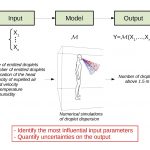
Turbulence modeling and particle dynamics are at play in numerous situations in which inertial/deformable/active particles are transported by a flow. This subject is of importance in many industrial and environmental situations as well as in health-related issues, and raises challenges in physical sciences, mathematics and numerical methods.
The CALISTO project team brings together a unique synergy between physics, mathematics and computational approaches for solving complex environmental simulation models of particle-laden flows and to address the following challenges:
- produce original answers (methodological and numerical) for challenging environmental simulation models, with applications to renewable energy, filtration/deposition technology in industry (cooling of thermal or nuclear power plants) and filtration/deposition, dispersion of materials or active agents (such as biological organisms, micro-robots);
- design new mathematical tools to analyze the fundamental physics of turbulence;
- develop numerical methods to analyze the displacement of micro-swimmers into a range of fluids such as water, non-Newtonian bodily fluids;
- optimize and control the displacement of artificial micro-swimmers;
- develop stochastic modeling approaches and approximation methods, in the rich context of particle-particle and fluid-particle interactions in complex flows.
- contribute to the numerical probability field with new simulation methods for complex Stochastic Differential Equations (SDEs) arising through multiscale Lagrangian Modeling of material/fluid particle dynamics with interaction.
Adopting a combination of microscopic and macroscopic descriptions, CALISTO’s strategy relies on an original and coherent methodology, mathematical frameworks supporting stochastic modeling, as well as sophisticated numerical methods in the field of computational probability.
Calisto is a joint Project-Team between Inria and CNRS, Cemef, throught the Computing and Fluids (CFL) research group at Cemef.
Our research directions
- Axis A – Complex flows: from fundamental science to applied models
- Axis B – Particles and flows near boundaries: specific Lagrangian approaches for large-scale simulations
- Axis C – Active agents in a fluid flow
- Axis D – Mathematical and numerical analysis of stochastic systems
- Axis E – Variability and uncertainty in flows and environment
Our international and industrial relations
- EDF R&D
- Zephyr ENR
- Uchile and Valparaiso University ; MERIC and Inria Chile
- IMP PAN in Gdansk
- IISC and ICTS Bangalore (through UMI IFCAM)
- IMPA Rio de Janeiro
- RIMS Kyoto University
- University of Bristol
- Helmholtz-Zentrum Dresden-Rossendorf
- Max Planck Institutes (Stuttgart)





